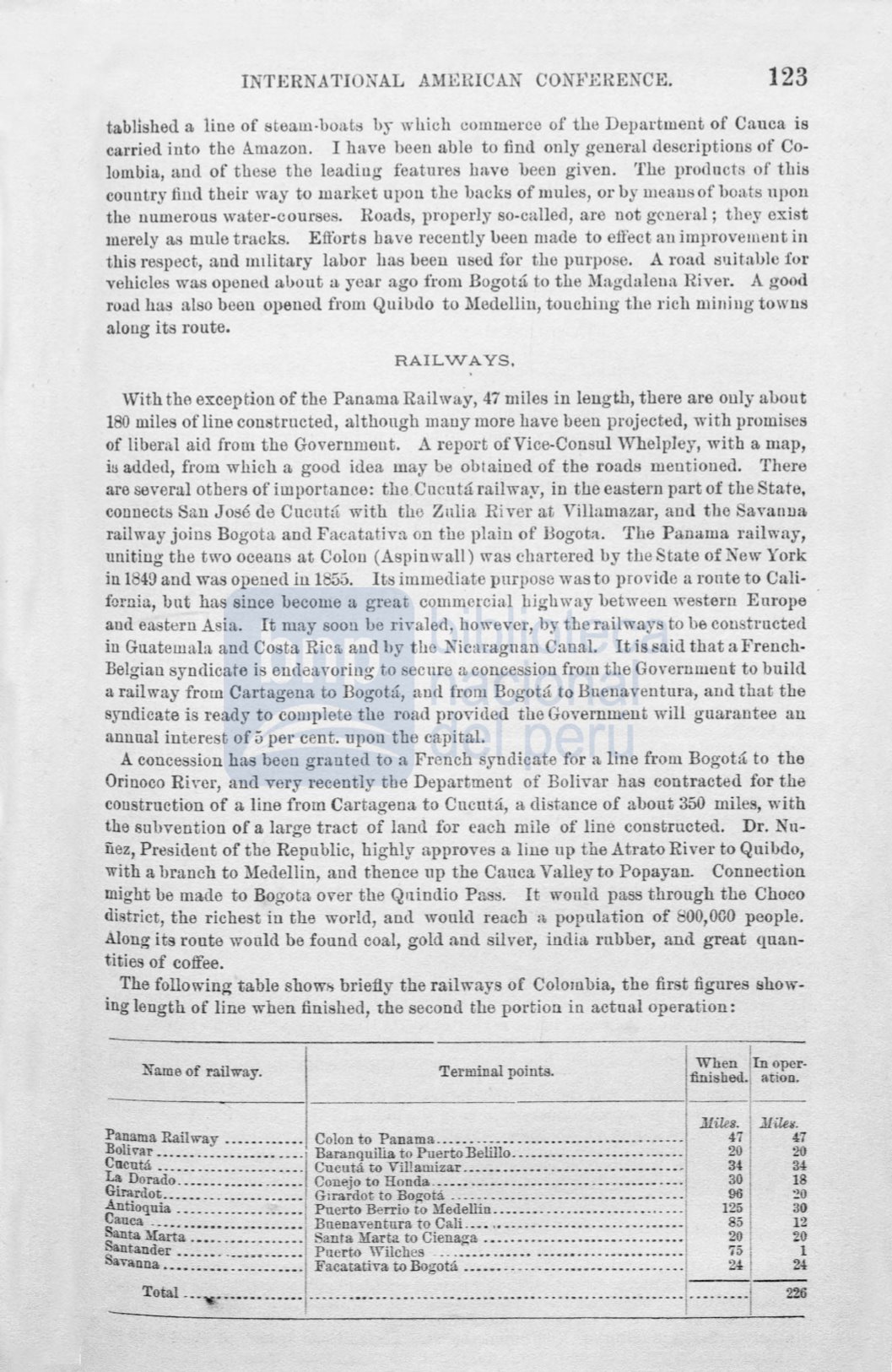

INTERN.ATIONAL AMERICAN
CON~'ERENCE.
123
tablished a line of steam-boat:; by which commerce of the Department of Cauca is
carried into the Amazon.
I have been able to nnd only general descriptions of Co–
lombia,
a.ndof these the leacling features bn.ve been given. The product of this
country nnd their way to market upon the backs of mules, or by mean of boa.ts upon
the numerous water-courses. Roads, properly so-called, are not g<'neral; they e::s:i t
merely as muletra.cks. Efl"orts bave recently been made to effectanitn})l'Ovementin
this respect, and rmlitary labor has been used ÍGr the purpose. A road sui tab1
for
vebicles was openetl about a year ago from Bogoti1 to the Mn.gdalena River. A good
road has also been opened from Quil.ldo to Medellin, touching the I'ich mining towns
along its route.
RAILWAYS.
With the exceptiou of the Panama Raílway, 47 miles in length, there are ouly about
180 miles of line constructed, althongh mauy more have been projected, with promises
of libera-l aid from the Government. A report ofVice-Consul WhelpJey, with a map,
iu added, from which a good idea may be obtained of the roads mentioned. There
are severa! otbers of importance: the Cncutá railway, in tlle eastern part of tbe State,
connects San José de Cucutá with the Zulia River at Villamazar, and tbe avanna
railway joins Bogota and Facatativa on tbe plain of Bogot:t. The Panama railway,
uniting the two ocean at Colon (Aspinwall) was cbartered
l>y
tlteState ofNew York
in
1
49 and was opened
iu
1855.
Its immediate purpose was to provide a ronteto Cali–
fornia, bnt has since become a great commercial bigbway between we tern Europe
aud eastern Asia.
It may soou be rivaled, bowever, by tbe rail ways to be con ·tructed
in Guatemala and Costa Rica, and hy tllc Tiearaguan Canal.
It is aid that a French–
Belgiau syndicate is endeavoriug to secnre a concession from the Governmen
t
to builcl
a railway from Cartagena to Bogotá, aud from Bogotá to Buenaventura., and that tbe
syndicate is ready to complete the road provided the Government will guarantee an
annual interest of 5 per cent. upon tbe capital.
A concession has been granted to a French syndicate for a line from Bogotá to the
Orinoco RiYcr, and very recently tbe Department of Bolívar has contracted for the
coustruction of a line from Cartagena to Cncutá, a distauce of about 350 miles, with
the subvention of a large tract of land for each mile of line constructed. Dr. Nu–
ñez, President of the Republic, highly approves a line up the Atrato River to Quibclo,
with a branch to Medellin, and thence up the Cauca Valley to Popayan. Connection
migbt be made to Bogota over the Qniudio Pass.
It
wonld pass through the Choco
district, the ricbest in the world, and would reach
:o
population of
OO,OGO
people.
Along its route would be found coal, gold and sUver, india rubber, and great quan–
tities of coffee.
The following table showf.! briefiy the railways of Colombia, the fir
t
figures ahow–
ing length of line when nnished, the second tbe portion in actual operation:
N
ame of railway.
Terminal points.
When
In
opcr–
fini
hed.
ation.
Miles.
Mile~t.
li~[~'Y¡~¡:¡¡¡;¡¡¡¡¡i jlJfli~~JI•¡¡¡;:¡¡¡¡¡;¡;~¡¡\¡¡~ i::~~~
1
~
i
a>anna. •••• ···--· ....••• -·- - Facata.ti;a. to
Bogotá ..•••... .. .. -- -···-··---- ... --...
24 1
2-l
_
Total ... --···-·--···· -------·· --- ----------------- ··- -- -- --- --------- --------
==¡~
















